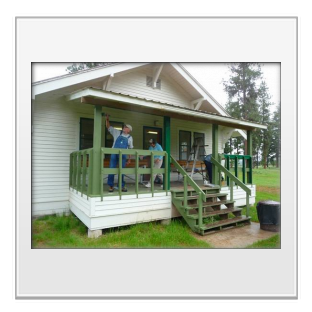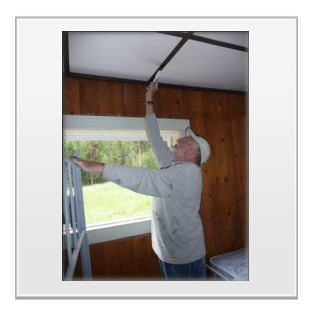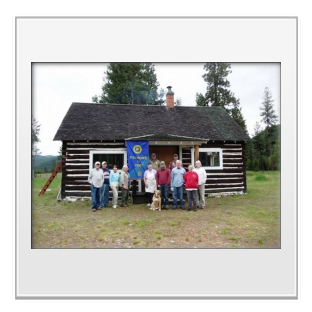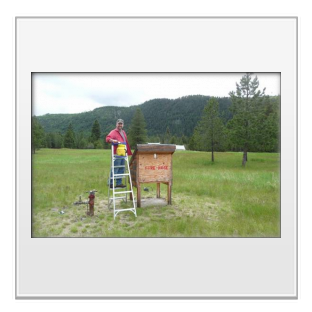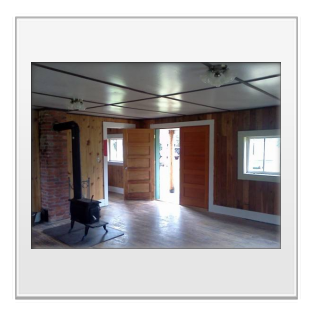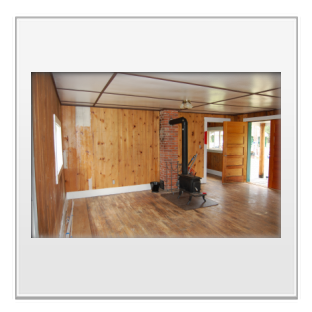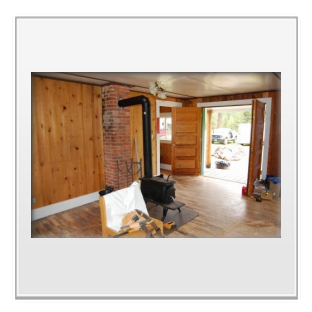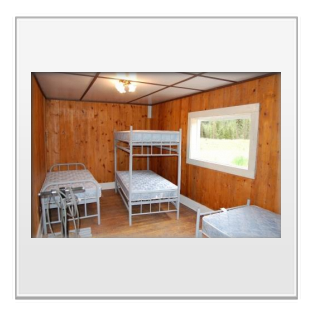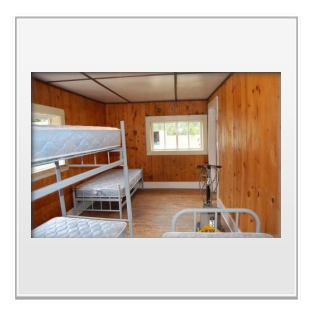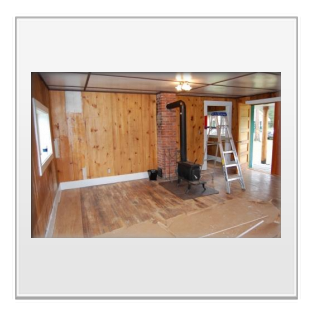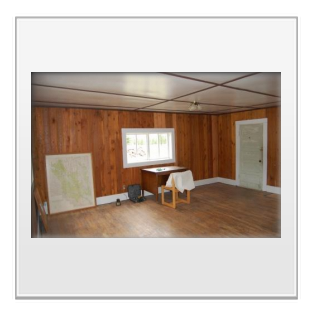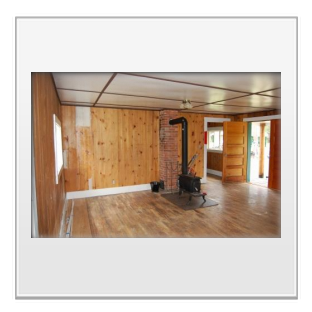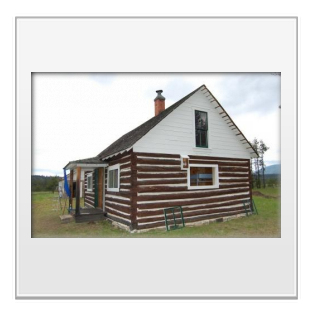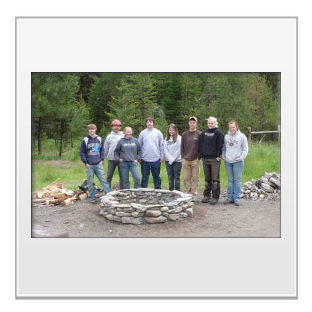Bend GS 2011 - Passport in Time
Main menu:
Previous Projects > States M-R
Bend Guard Station Compound Restoration 2011
Lolo National Forest, Montana, 2011
PIT crew helps restore Bend Guard Station
The work can be tedious, often repetitive. The wages paid for that work are minimal…actually, nonexistent.
But, for Passport in Time (PIT) volunteers from all over the United States, working on projects like the recent Bend Guard Station Restoration Project, the payoff is the process of giving something back, of making a serious attempt at preventing the marks history made in the past from turning into the marks of that history lost in the future.
In this instance, government employees and concerned members of the public hoping to make a long-lasting difference attempted to preserve some meaningful local history by restoring the Bend log cabin Ranger Station, which was originally constructed sometime after 1910, and working on some of the other facilities located on the grounds of the historic guard station.
"Bend," as it is simply referred to locally, is located approximately 31 miles north of the Thompson River's confluence with the Clark Fork River, just north of the county road. It was frequently used as a work center over the past several decades, but was once a working district ranger station on the old Cabinet National Forest. The historical significance of the place has become apparent, and some folks will now enjoy re-living that history through the Forest Service's well-received cabin rental program, of which Bend's bunkhouse building is already a part.
"The ultimate goal is to get the ranger station building into the cabin rental program," said local contact for the project Mark Smith of the Plains/Thompson Falls Ranger District, regarding the almost century-old, two-room structure, which was originally built in response to the historic fire season of 1910. "We would like to re-create the entire early 1900s-type experience, which, for this building, would mean no running water and primitive facilities, just like it was back then."
Joined by Smith and several other U.S. Forest Service employees, nine dedicated volunteers, working through PIT, a national cultural heritage program sponsored by the Forest Service, were hard at work restoring facilities at Bend the week of June 13th through 17th of this year.
The main emphasis of this particular Bend PIT project (a previous project was accomplished at Bend in 1998 and more work is planned in the coming years) was to refurbish the ranger station building and finish work on the bunkhouse/cookhouse building that was erected at the guard station in the 1920s. During this phase of the project, the installation of Upson board in the log building and the painting of the facility and the bunkhouse were the first tasks.
Lolo National Forest Archaeologist Ed DeCleva was a key player in getting the work accomplished. Ed knows the history of Bend as well as anyone, and pointed out some of the mystery still hidden behind that history. It was originally part of the old Cabinet National Forest. It was headquartered in Thompson Falls, and formed largely in response to the chaotic fire year of 1910, when over 3.5 million acres of National Forest in Idaho and Montana burned. Afterward, the Cabinet National Forest was dissolved, and the forest's land was merged with the surrounding Kootenai and Lolo National Forests in 1954. That is when the Bend site officially became part of the Lolo National Forest.
Bend was named for the "sharp bend in the river about three quarters of a mile above the site," according to documents from that period. DeCleva reports that the Executive Order finally designating the site for use as a Forest Service facility did not go through until 1918, though there is evidence it may have been utilized before the official paperwork went through. "The driving force behind the establishment of the Bend Ranger Station was the realization that the Forest Service needed a permanent presence, a station of oversight to operate from in this rather large area," said DeCleva. "The Cabinet National Forest supervisor requested the site for administration of Forest Service lands. Congress authorized that request in 1911 but President Woodrow Wilson did not sign the executive order until 1918, which means we don't know precisely when the ranger station was built." That mystery is something that will be established through future research.
However, even without knowing the exact date of construction, DeCleva and his associates - fellow Lolo National Forest archaeologist Erika Karuzas, and forest employees Norma Staaf and Witne Neil, who both visited and helped at the site on June 15 - still realize the historic significance of the Bend Guard Station and the role it should play in the modern organization.
Currently a highly valued property and part of the Lolo National Forest Heritage Program, the Bend Guard Station and its associated grounds have been determined eligible for listing with the National Register of Historic Places for its association with early Forest Service activities on the upper Thompson River and in northwest Montana.
With the support of the popular PIT Program's volunteers, restoration work on Bend is in full swing.
The main idea is to make things as historically correct as possible, in both form and function, while correcting any problems (such as the lead-based paint which was commonly used in this era; it will eventually be carefully removed from the site) that may be encountered.
During the last week of the project, Mark Hendrickson of McMinnville, OR, Susan Northcutt and Elaine Rex of Mountain Home, Idaho, and Gene Shuman and Sue Kovach Shuman of Fairfax, VA, were hard at work installing Upson board and wooden trim in the interior of the ranger station log cabin, and painting the exterior. At the bunkhouse, Charles Sherfey of Chapin, SC, and Rick and Mary Gant of Richland, WA, were carefully painting the back porch, while cook Sharon Attebery of Westcliffe, CO, prepared meals and baked bread.
On one day, a crew of eight local teenagers from the Youth Conservation Corp, led by Kim Earhart of Plains, joined us. They rebuilt the area's communal fire pit behind the bunkhouse.
PIT volunteers have proven to be highly capable individuals from many different fields of expertise; they have been an integral part of many different types of projects over the years. According to the organization's mission statement on the Passport in Time website, "PIT volunteers work with professional FS archaeologists and historians on National Forests throughout the U.S. on such diverse activities as archaeological survey and excavation, rock art restoration, archival research, historic structure restoration, oral history gathering, and analysis and curation of artifacts."
The Lolo National Forest receives higher marks from PIT workers than many others due to its practice of supplying full-time cooks to each project - not every Forest provides this particular perk. Attebery, who is on the PIT "Honor Roll" with over 1,500 hours of volunteer service logged to date, was the incredibly good cook that the fortunate Bend volunteers had working for them during the project. She says that she has worked on PIT projects on the Flathead and Gallatin National Forests, but thinks that the Lolo is the best to work on. "The Lolo is by far my favorite, and it is my favorite because the staff are so good to us," she said. "They are always organized, and we always get a lot done. They provide volunteers with things like showers, which are important after working all day." "And food!" she added. "It is very important to have food provided. As a volunteer, to be fed is wonderful."
Outside of Attebery's mighty fine cooking, the work at Bend Guard Station seems to have been received favorably by PIT volunteers. "A lot of the folks are saying that Bend is the nicest facility they've ever worked on for a PIT project," DeCleva said. Thanks to all of you who made this project possible; we could never have done it without you!
